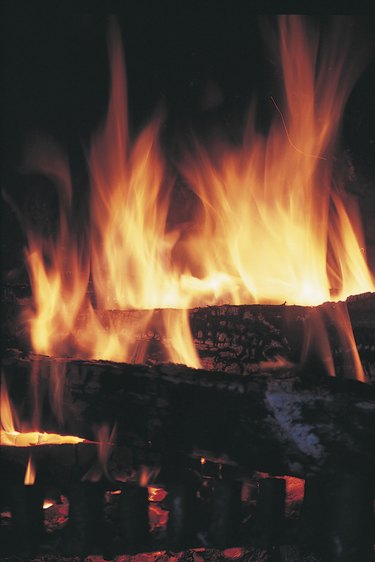
Although the beauty of a tree and its welcoming shade is lost when it's felled for use as lumber or firewood, a fast-growing replacement tree reduces the time needed before shade returns or wood harvesting is again possible. The vigorous empress tree (Paulownia spp.) provides an alternative wood for use a lumber or fuel in areas of the world where forests are absent or renewable tree farming practices are sought. Burning Paulownia wood is possible, although curing the wood properly increases its flammability.
Paulownia Trees
Video of the Day
Native to eastern Asia, trees in the genus Pawlonia grow quickly, creating a wide-spreading root system. The trunks are considered hardwood, containing lightweight but strong wood fibers that doesn't rot quickly. Once chopped down, the roots quickly sprout new shoots called suckers or watersprouts. Removing all but one sucker leads to a rejuvenation of a singular tree trunk that can provide a cubic meter of hardwood in as little as eight years.
Video of the Day
Fuel
Paulownia wood tends to resist heat and burning initially, as it is full of moisture after being freshly obtained from the felled tree. However, curing or drying smaller pieces of Paulownia wood is fast compared to other hardwood such as oaks, poplars, ashes or maples. Because the wood isn't very dense, it burns more quickly than denser hardwoods, therefore a more convenient source for charcoal. The larger boles are retained for use as lumber, while smaller branches are typically used as inexpensive, renewable sources of fuelwood in parts of China as well as in Africa.
Curing
Since Paulownia wood already naturally shuns heat and isn't easy to ignite, properly cutting and curing wood is necessary. While the felled tree is still fresh, cut up the bole and side branches in to smaller pieces as soon as possible. Hardwoods cure from the outermost tissues inward. Cutting logs into quartered or smaller sections and pieces increases surface area for more rapid drying. Rather than cutting up logs and air-drying them for 12 to 24 months, Paulownia wood can dry successfully in as little as 30 to 90 days if air is warm and dry. Once Paulownia wood dries to 20 to 30 percent moisture levels, it's cured and ready for use as firewood. Drier wood is even better.
Use
Do not start a fire with Paulownia wood. Instead, begin the fire with faster burning softwoods such as fir or pine. Then add smaller, split pieces of Paulownia to the roaring softwood fire to get it to ignite better. Stack the wood pieces so ample air feeds the flames; do not stack wood in parallel configuration because it limits air flow and the temperature of the fire. Use a mixture of Paulownia logs with other hardwoods in the fire rather than relying solely on the Paulownia to create the perfect blaze.
- Crop Development; The Paulownia Tree: An Alternative for Sustainable Forestry; Sedeer el Showk, et al.; 2003
- Hearth, Patio & Barbecue Association: Wood Burning FAQs
- The International Development Research Center; Paulownia: China's Wonder Tree; Chin Saik Yoon, et al.; 1986
- Master Sweep: Best Burning Wood